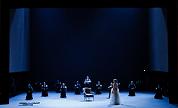“Twenty-four hours of doubt minus one minute of hope,” wrote Georges Bernanos about Christian faith. When La Scala in Milan asked Francis Poulenc in 1953—one year after the Paris premiere of “Dialogues des Carmélites,” a play written by Georges Bernanos—to compose an opera, the composer saw it as a sign: “the heavens have placed the subject of my dreams in my path.” From its presentation in 1957 in Milan to the premiere at the Nice Opera on Thursday, October 7, in a production by De Nederlandse Opera, the work has not aged a day. The lyrical establishment in Nice certainly did not skimp on names: under the masterful musical direction of Michel Plasson, the Philharmonic Orchestra, and the Choirs of the Nice Opera achieve a meticulous reading of the three “parlando” acts of the libretto, without ever compromising the deployment of their dramatic intensity. Robert Carsen’s carefully crafted staging conveys the radical opposition between the ascending verticality of spiritual elevation and the lateral chaos of the revolutionary crowd’s movements. A skillful dissolve ingeniously maneuvers the latter to change Michael Levine’s refined sets, avoiding breaks in rhythm in the successive parade of the twelve scenes. The lighting designs by Jean Kalman, realized by Jurgen Kolb, contribute fully.
In the role of Blanche de la Force, soprano Karen Vourc’h remains consistently in a vocal register that expresses an inexhaustible inner strength, always imbued with restraint in high notes. This is evident in her various duets: the one where she reproves the proud childishness of Sister Constance (Hélène Guilmette) or her tumultuous farewells with her brother, the Chevalier de la Force (Frédéric Antoun). In her restrained interpretation of the uncompromising Mother Marie of the Incarnation, mezzo-soprano Sophie Koch—suffering declared before the curtain rises—almost regrets this limitation, risking confusion between the coldness imposed by the role and vocal neutrality. The performance of the Prioress in the last two acts, transcended by her faith (June Anderson), also convinces. The audience, however, gave a special ovation to the scenic and vocal tour de force of mezzo Sylvie Brunet, the first Prioress whose terrible agony leads her to scream her ultimate “fear of death.”
This tormented disappearance that marks the end of Act I is also a major turning point punctuated by the intermission: long exposition scenes with passages in the first part could have induced slight boredom in some. This response stems less from the music than human nature: once past the necessary acclimation to the syllabic declamation, the audience still resists the idea of entering the mystical drama by accepting to abolish its “self.” Indeed, the first four tableaux prepare the understanding to follow Sister Blanche of the Agony of Christ toward the fulfillment of her tragic destiny. “Be detached from your own detachment,” she is ordered by Madame de Croissy, the Prioress, upon entering Carmel. It’s Jeanne Guyon inspired by the “abyss-God” of Meister Eckhart or the serene renunciation of philosopher Simone Weil.
Subtly choreographed by Philippe Giraudeau to reach a rare dramatic climax, the final scene, where voices fade away to the chilling metallic sound of a guillotine blade, sees Sister Blanche—graced by Paul’s grace after faltering—join the procession of those condemned to the scaffold in absolute will. This figure recalls one mentioned by psychoanalyst Catherine Millot, that of “Etty Hillesum seeing Edith Stein and her sister pass by in August 1942, wearing the yellow star on their Carmelite dress” before, through a mysterious internal “consent,” going to join them in death at Auschwitz on November 30, 1943 (La Vie Parfaite, Coll. “L’Infini,” NRF Gallimard, 2006). “Twenty-four hours of doubt minus one minute of hope.” At the Nice Opera, these “Dialogues des Carmélites” offer two and a half hours of eternity.
Photos: D. Jaussein


